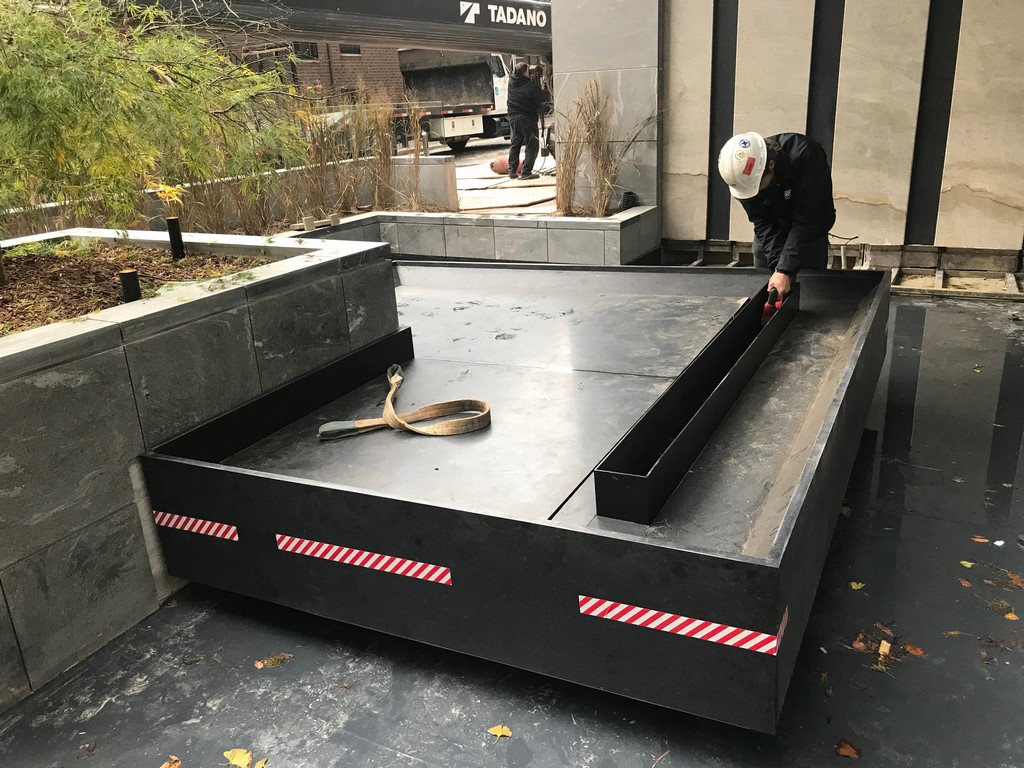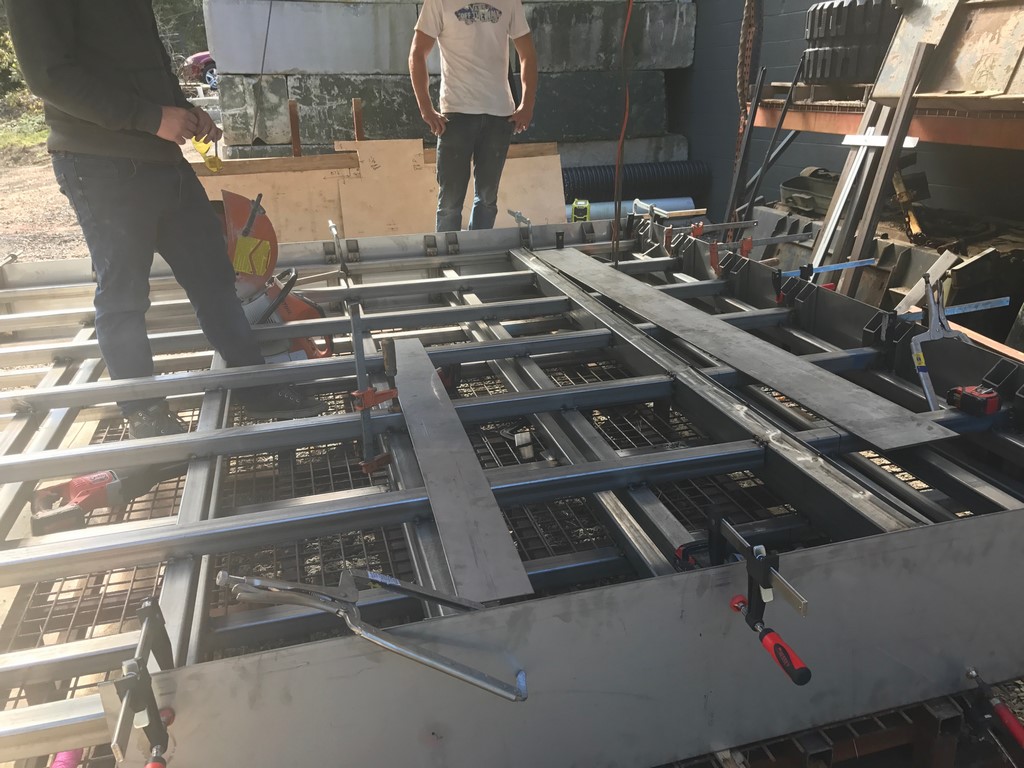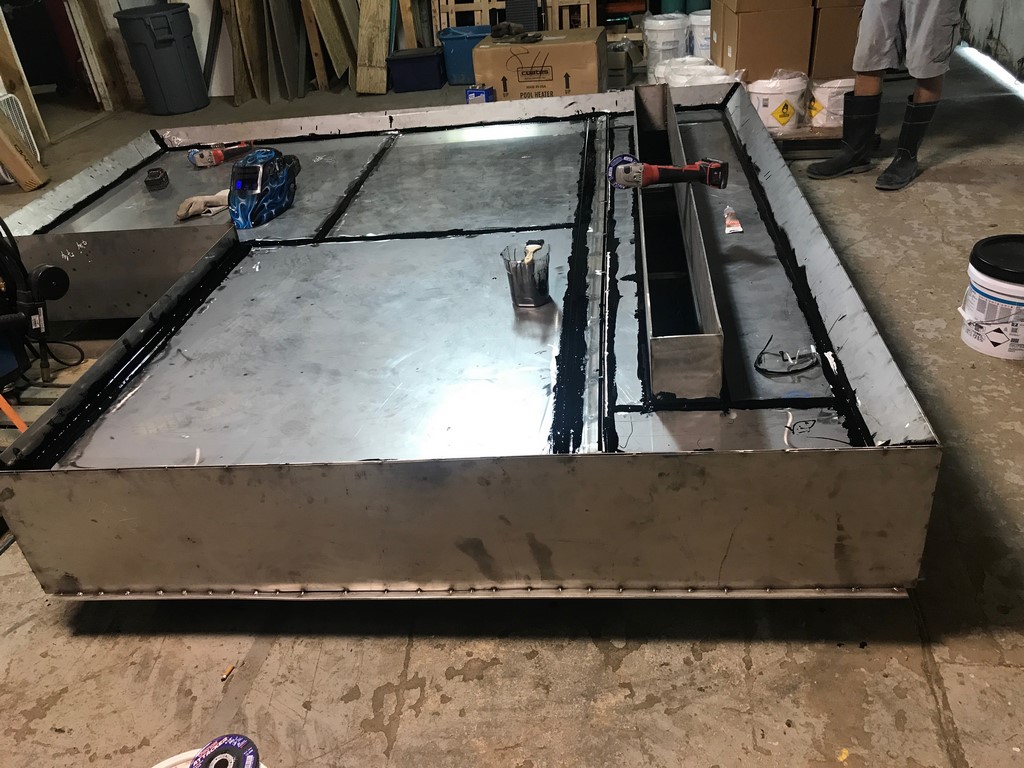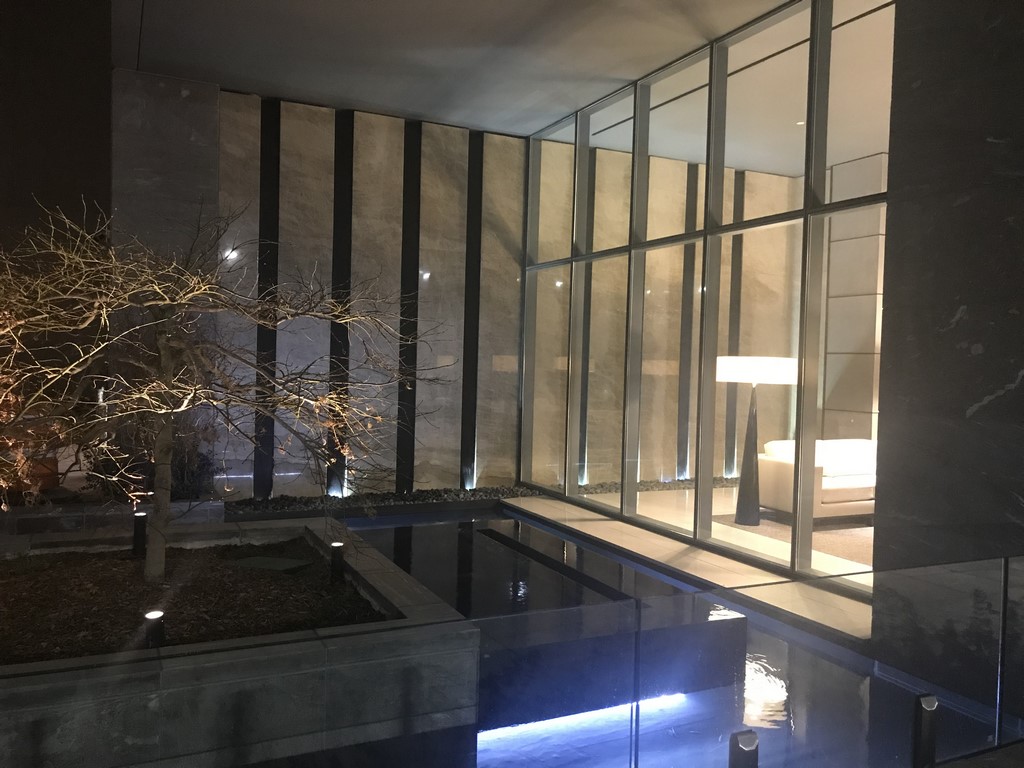Public Pursuits
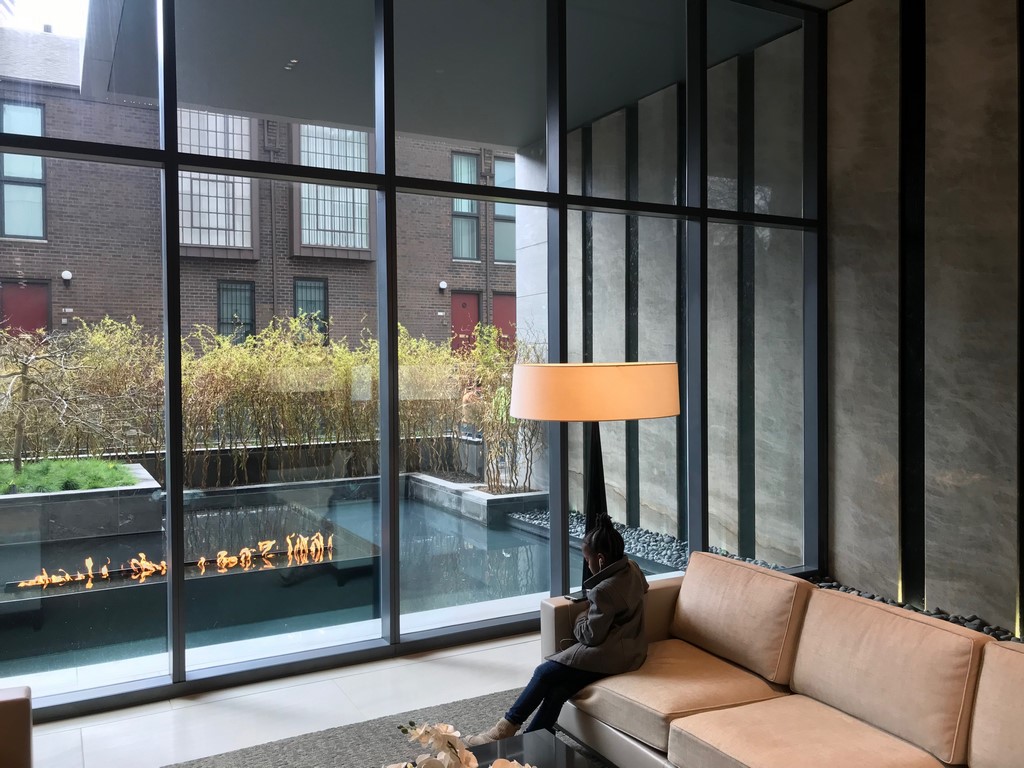
Among the best things about Philadelphia is its stock of public art – and that’s not accidental: For many years, all construction projects in specific neighborhoods reaching certain dollar thresholds have been required to include an accessible work of art within their footprints. Whether it’s a sculpture, a mural, a statue celebrating a Founding Father or a waterfeature, the city now boasts more than 1,000 of these art pieces, each one part of an outstanding cultural and historical landscape.
One of our recent projects fit within this program: Located just across the way from Independence Hall, it’s part of a 26-story residential tower situated on a narrow lot in one of the city’s oldest and most historic neighborhoods (meaning extremely narrow streets and lots of traffic). Its contribution to the city’s artistic tapestry is a large interior/exterior water wall alongside a water table/fire feature over a large basin.
Given limited space, this waterfeature had to be tucked into a covered area adjacent to the building’s entrance – a tight but workable fit. Cecil Baker + Partners (Philadelphia) developed the fountain concept in consultation with Kusser Fountainworks (Tampa, Fla.). When the need arose to find a company to complete the program, the fact that we’d previously worked with the architect on a rooftop project involving an interesting vanishing-edge waterfeature put us in contention.
WORKING ASSETS
We at Outerspaces (Glen Mills, Pa.) have been in business since 1990, with an original focus on high-end residential pools and landscapes. About 15 years ago, we saw an opportunity and began including fountain work among our capabilities – both restorations and new installations – and have never looked back: It was a small part of what we did in 2003, but now it represents a good half of our annual revenues.
So when this public-art project came up for bid, we threw our hat in the ring knowing that local knowledge would be a big help: We’re familiar with the travails of working in downtown Philadelphia, and we also know that it’s a strong union town where understanding the dynamics of the labor market is a substantial advantage. Those two factors limited the bidding pool considerably, and we won the contract.
The best thing about our work on fountains is that it led us many years back to develop in-house capabilities in metal fabrication. So much of our work in both restorations and new fountain installations required custom components – manifolds, support structures, frameworks and more – that it just made sense to head in that direction. And now that these capabilities are known, we’re even being asked to get involved in projects that don’t involve water at all, including one in which we’re using our skills to craft a transit station.
But long story short, this project was right up our aquatic alley.
| Delivering the panels was a high-pressure venture, partly because the street is among the narrowest in the downtown area, but partly because the components we were working with were awkwardly large and heavy. A crane helped us get the paired water walls and the water table close to their final positions, but then it was a matter of finessing pieces into spaces beneath the overhang. It all came together, but it was stressful. |
As was mentioned above, the project included a pair of waterwalls – one inside the building in a large common/lobby space, the other on an exterior wall. They’re similar in appearance and positioning, but they are actually separate systems. The indoor unit is clad in stainless steel with water flowing down into a small basin. Here, the water recirculates through a filter and treatment system before being delivered back to the top of the wall. The outdoor system is more complex, with the water from both the wall (this one clad in stone) and the black-granite table operating on a single system that draws from a trough at the base of the wall and from the basin surrounding the table and its fire feature.
Both systems are quite simple hydraulically, but the path to getting everything in place was far from straight and clear. Helpfully, we were involved in the process early enough that we were able to place our pipes within the steel cage of the building’s foundation structure before anything was set in concrete. But what this meant is that we placed our pipes and were essentially banished from the property for an extended period of time as other contractors did their work.
To say we were low on the hierarchical totem pole would be putting it mildly: We were the fountain guys working on the ground floor of a high-rise project for which the penthouse alone was recently purchased for nearly $18 million. If we didn’t know just how peripheral we were to anyone else’s activities or sense of value to the project, our fellow contractors were willing to remind us of our menial status on a steady basis.
MAKING PROGRESS
In the early stages, we were just the annoying guys whose sole interest was inserting 34 big pipes into in the building’s 24- to 36-inch-thick ground-floor deck. Once that was done, we truly had nothing to do on site for many months – and when we came back, found that our work had been about as respected as we had been: A couple of our stub-outs had been broken, for example, and one thoughtful plumber had run lines immediately below a couple of the open pipe outlets in our equipment area.
We’ve had enough experience with this sort of construction to know that taking these indignities in stride is just part of the job: Recognizing we had to be the best team players in the whole world to get any support at all, we kept these annoyances in perspective, splicing in and pressure-testing new stub- outs and figuring out ways to bypass any and all obstacles put in our path.
We had also been quite busy with the project while we were off site, fabricating the wall sections and the water table from stainless steel in our shop. Our ambition was to make these components as complete as possible to simplify and speed our work on site. First, we knew exactly how narrow the street is in front of the building and all about the city’s low tolerance for traffic blockages. Second, we figured that the more rapidly our prefabricated modules slid into place, the sooner we could get out of everyone else’s way.
For this project, we also set up a brand-new stone-fabrication unit in our shop, purchasing saws, grinders and polishing equipment and tasking our staff’s lead stone mason with getting fully up to speed with these new tools. As had previously been the case with our metal-working shop, it was an investment that made sense not only for this project, but also for others we know we’ll be tackling in the future.
When the time finally came to deliver our prefabricated components to downtown Philadelphia, we faced all of the hurdles involved in working on a busy street while inserting large, heavy, cumbersome objects by crane and cart to an area beneath an overhang. The wall panels were the “easy” part: We placed them on low, wheeled dollies and jockeyed them into position using come-alongs and brute strength.
| One of the reasons things went as smoothly as they did when we delivered our modules was the fact that we’d done so much finished fabrication off site – cutting, drilling, welding, completing and testing so much of our work off-site that when we arrived at the job site it was largely a matter of wrestling the big pieces into place and making quick work of well-placed plumbing, gas and electrical connections. |
The 6,000-pound water table was a different matter, because we had to lift it over a planter box on the street side of the space. This was more of an adventure by far, but a similar combination of winches, lumber and sinew wrestled the structure into place – greatly assisted in this case by a 55-ton crane. Once these placements were done, it was a matter of making some basic plumbing connections and initiating the systems.
We helped ourselves here by pre-packaging the equipment set on a pair of pallets, with everything pre-wired, plumbed together and ready to make the necessary external connections. It may be a bit of an exaggeration, but we were about 95 percent of the way there once we slid our pallets into place – and again, we knew that the less time and energy we had to expend on site, the better.
We used equipment from Pentair (Sanford, N.C.) in our vault, selecting variable-speed pumps so we could precisely dial in our flow rates for optimal performance of the two walls and the water table. The water is heated (although at a chilly level most of the time) to keep the systems running no matter how cold it gets outside. All systems (including the fire feature as well as LED lights from Jandy in Vista, Calif.) are controlled using Pentair’s ScreenLogic system and its IntelliTouch interface. This gives building management the ability to control all functions using a simple phone app.
We had one final advantage: As a local firm, we were able to sign on to provide regular service for the fountain system. Philadelphia is a clean city, but it has many trees – including a nice Japanese maple in the planter right next to our outdoor basin. So leaves do accumulate, and we’re there to clean things up, especially important in the fall when the debris burden gets particularly high.
BUILDING CREDIBILITY
One of the many reasons we found our way to fountains is that, as watershape and landscape specialists, we are at our happiest and best when we find both variety and challenge in our work. To be sure, every high-end pool project is a distinct, one-off proposition, but as our business matured, we were looking for more.
We’ve found all of that with fountains: Each is truly a one-of-a-kind production with a highly individualized creative process matched up with different spaces, conditions, functions and features. Each one calls on our skills as designers and builders in ways we never could have anticipated when we started moving in this direction 15 years ago.
As a business that operates in an area with distinct seasons and long winters, we’re happy with the fact that fountain operations related to metal and (now) stone fabrication enable us to keep more of our staff together at times when working outdoors simply isn’t possible. Grinding and polishing may not be the most enjoyable work they do, but it’s better than scrambling for off-season jobs and exposes them to new processes and skills.
We’re also aware that what we’re doing in these projects, particularly in a place as crowded as downtown Philadelphia, is extremely public. This puts a premium on professionalism and our awareness that there are eyes everywhere, including curious members of the community and, more important, our fellow contractors.
| The completed waterfeatures are slick, sleek and understated – a cool complement to lobby space and the luxury residences our on-site colleagues were preparing over our heads. Day and night, the sounds of the waterwalls, the flickering flames and the reflections off the water table make this a worthy addition to Philadelphia’s rich civic tapestry. |
Indeed, this contractor connection is both fascinating and valuable: On this water wall/water table project, for example, tradespeople passed by our work areas daily and would often strike up conversations when they noticed that our work reflected their trades. So we ended up talking shop with masons, steel fabricators, stone specialists, plumbers and electricians and picked up the strong impression that they were impressed by how much we rolled up into our work – a mixing of several of their trades in one operation.
A while after we finished this project, we were on site at another and recognized some of the masons. Where before they’d been chilly and not very helpful, it was now as though we were old friends: When they had problems, we’d help them out and vice versa – and we’ve found this same sort of collaborative dynamic repeating itself from project to project as we’ve become more and more involved in fountain work.
While the mutual back-scratching is nice, we’ve also noticed that, job by job, we’re becoming part of a greater design/construction community, surrounded by a ready-made team of experts. It’s both gratifying and helpful, because we’re getting involved earlier and earlier, being asked to participate creatively and enjoying increasing levels of respect.
Philadelphia’s a huge marketplace, of course, and digging into the fabric of a community so large takes a long time. It’s all about getting the lay of the land, figuring out ways of fitting in and learning how to be helpful beyond our specific assignments. After 15 years, it looks like we’re truly on our way!
Robert Nonemaker is co-owner of Outerspaces Inc., a design/build firm based in Glen Mills, Pa., that specializes in large, complex, high-end residential and commercial landscape, pool and fountain projects. He also owns Robert Nonemaker Exterior Design, a firm that offers design- and construction-consulting services to architects and landscape architects throughout the country.















